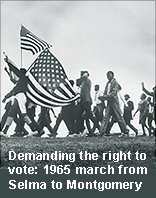Justice
VR Amendment
Electoral College
Congress 2005
Ohio 2004
Why it Matters
Voting History
Voting FAQ
Home
History of Voting Rights in America
The struggle to recount the votes in 2004 and guarantee fair and open elections is just the latest chapter in the centuries-long struggle to make sure that we honor the ideal of one-person-one-vote. This recount effort is not just about George Bush, John Kerry, or even the Green and Libertarian candidates. It is about defending a right that is at the very foundation of democracy in this country.
Only Free White Men with Property Can Vote
There is no right to vote in the United States Constitution, so each state’s standards have evolved separately unless federal laws were passed that applied to every state. When this country was founded, only white men with property were routinely permitted to vote (although freed African Americans could vote in four states). White working men, almost all women, and all other people of color were denied the franchise.
By the time of the Civil War, most white men were allowed to vote, whether or not they owned property, thanks to the efforts of those who championed the cause of frontiersmen and white immigrants (who had to wait 14 years for citizenship and the right to vote, in some cases). Literacy tests, poll taxes, and even religious tests were used in various places, and most white women, people of color, and Native Americans still could not vote.
African American Men Get the Vote
In 1866, the 14th Amendment to the federal Constitution was passed, guaranteeing citizenship to the former slaves and changing them in the eyes of the law from 3/5 of a person to whole persons. Then, in 1869, the 15th Amendment guaranteed the right to vote to black men, with most women of all races still unable to vote.
1869 also marked the beginning of “Black Codes,” or state laws that restricted the freedoms of African Americans. Among the freedoms restricted was the freedom to exercise the right to vote. Literacy tests, poll taxes, hiding the locations of the polls, economic pressures, threats of physical violence, and other strategies to suppress the African American vote were either found in the Black Codes or flowed from them.
While strategies such as these are no longer legal, some have argued that the misallocation of voting machines in 2004 so that whites in Republican-leaning districts had short lines and minorities in Democratic-leaning districts were forced to miss work to wait in long lines was equivalent to placing a new poll tax on African American and other minority and poor voters.
Women Get the Vote
Initiatives to promote voting for women have been traced back to the 1770s, but the modern movement for a vote for women traces its beginning to the Seneca Falls Convention in 1848, when supporters of a Constitutional Amendment to allow women to vote came together. While their movement was slowed during the Civil War years, the two major suffragist organizations united after the war and pushed forward with a movement that culminated, after many difficult years, in the Nineteenth Amendment in 1920.
Native Americans, Asian Americans, and Latinos Get the Vote
Some Native Americans became American citizens if they gave up their tribal affiliations in 1887, but many did not become United States citizens until 1924. Many Western states, however, continued to deny the right to vote through property requirements, economic pressures, hiding the polls, and condoning of physical violence against those who voted.
Asian Pacific Americans were considered “aliens ineligible for citizenship” since 1790, and interim changes to naturalization and immigration laws in 1943, 1946, and 1952 give the franchise to some but not all immigrant Asian Pacific Americans. Nevertheless, because citizenship is a precondition of voting, immigrant Asian Pacific Americans did not vote in large numbers until after 1965, when the immigration and naturalization laws were changed.
Asian Pacific Americans born on American soil were American citizens and had the right to vote. When 77,000 Americans of Japanese ancestry were put in American concentration camps during World War II, however, their right to vote was not allowed.
For Mexican Americans, those in Arizona, California, Nevada, New Mexico, and Texas were supposed to get voting rights along with American citizenship in 1848, when the Treaty of Guadalupe-Hidalgo ended the Mexican American war. Property requirements and literacy requirements were imposed in those states to keep them from voting, and violence and intimidation were used against anyone who dared to exercise the franchise.
The Sons of America organized in 1921 to fight for equality and the right to vote, but all Mexican Americans did not receive the right to vote until 1975.
The Movements of the 1960s and 70s
The federal Voting Rights Act of 1965, enacted thanks to the pressures of Dr. Martin Luther King and a powerful civil rights movement, banned literacy tests and provided federal enforcement of voting registration and other rights in several Southern states and Alaska.
Five years later, the Voting Rights Act of 1970 provided language assistance to minority voters who did not speak English fluently. Asian Pacific Americans and Latinos were major beneficiaries of this legislation.
Current Issues
Thanks to a movement led by differently-abled Americans and their supporters, the Americans with Disabilities Act of 1990 was passed. It provided for ballot and poll access for those with disabilities. Enforcement of the Voting Rights Act and other laws continued.
After the 2000 election, the nation was confronted with over a million ballots never being counted, and numerous allegations of fraud in Florida and elsewhere. The courts forced the recount in Florida to stop, and it was only months later (right after the September 11 attacks, so few were listening)that recounters hired by major news organizations found that if all the valid, machine-rejected votes had been counted, the man occupying the White House would have lost the election (SOURCES: 1 [SEE TABLE 1]; 2; 3).
In the 2004 election, the struggle continued, as challenges were raised to unfair voting practices in Ohio and other states. The use of electronic voting machines that leave no paper trail, massive removals of alleged felons from voter rolls, misallocation of voting machines so that minority districts have disproportionately fewer machines, and other issues were still prevalent. The Government Accountability Office started an investigation, and several states started recounts.
An embarrassing vestige of accomodation to slavery and segregation. Find out why we should toss this undemocratic and antiquated contraption onto the junk-heap of history. more
Greens support elections and governing processes that increase public participation. more
State and local Green officials serve across the U.S., from California and Colorado to Maine and Washington, D.C. more
Our political system should bring us together as one nation, not divide us against one another. more
Sustainable Future
Ending our fossil fuel dependency will help build a sustainable future for our children. more





